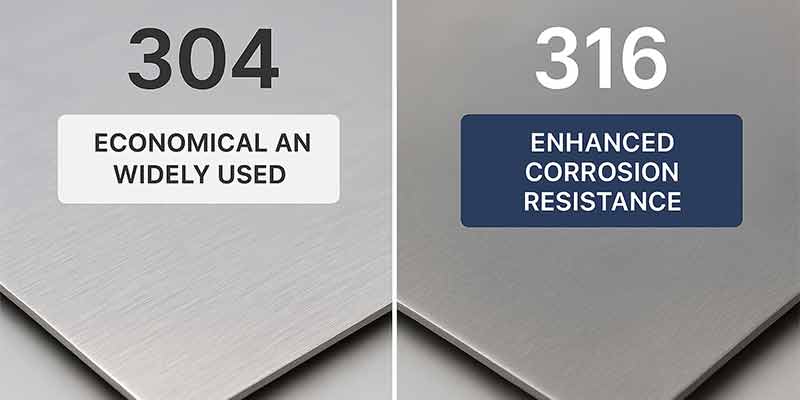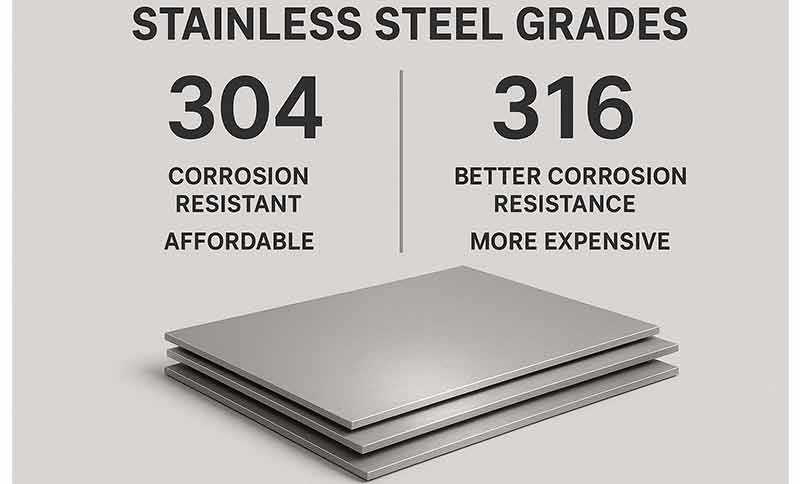El acero inoxidable es uno de los materiales más utilizados en diversas industrias, desde la construcción y la arquitectura hasta el procesamiento de alimentos y las aplicaciones marinas. Entre los numerosos grados disponibles, 304 y acero inoxidable 316 Son los dos más comunes. Pero ¿en qué se diferencian y cuál es la mejor opción para tus necesidades?
En este artículo, responderemos preguntas comunes sobre el acero inoxidable 304 y 316, respaldados por referencias de fuentes autorizadasy ayudarle a tomar la decisión correcta para su proyecto.

El acero inoxidable 304 es generalmente más económico que el acero inoxidable 316.
304:Conocido por su asequibilidad y versatilidad, lo que lo convierte en el grado de acero inoxidable más popular.
316:Más caro debido a la adición de molibdeno, lo que mejora su resistencia a la corrosión.
📌Según Materiales AZO y Outokumpu, el 316 normalmente cuesta entre un 20 y un 30 % más que el 304.
Si bien el acero inoxidable 316 es altamente resistente a la corrosión, también presenta algunas desventajas:
Mayor costo de 304.
Menor disponibilidad en algunas regiones debido a la reducción de la demanda en comparación con el año 304.
Fuerza ligeramente menor en determinadas condiciones en comparación con los aceros inoxidables especializados.

Tanto el acero inoxidable 304 como el 316 se utilizan ampliamente en la industria de alimentos y bebidas.
acero inoxidable 304:La opción estándar para aplicaciones de grado alimenticio, como utensilios de cocina, equipos de cocina y tanques de procesamiento de lácteos.
acero inoxidable 316:Preferido en entornos con alta exposición al cloruro, como el procesamiento de mariscos, las condiciones de agua salada o la fabricación de productos químicos.
📌 El Administración de Alimentos y Medicamentos de los Estados Unidos (FDA) y Autoridad Europea de Seguridad Alimentaria (AESA) Reconocer el acero inoxidable 304 como seguro para alimentos.
No. 304 es más asequible que el 316 porque no contiene molibdeno, lo que eleva el coste de producción del 316.
El “mejor” acero inoxidable depende de la aplicación:
304:Ideal para uso general, equipos de calidad alimentaria y decoración de interiores.
316:Lo mejor para entornos marinos y aplicaciones con alto contenido de cloruro.
Otros grados como 310 (alta resistencia al calor) o 430 (acero ferrítico rentable) puede ser mejor para usos especializados.
Elija 304:Para cocinas, arquitectura, mobiliario de interior, ascensores y paneles decorativos.
Elija 316:Para proyectos costeros, industrias químicas, equipos farmacéuticos y entornos marinos.
Para paneles decorativos de acero inoxidable, Ferosteel Ofrece acabados 304 y 316 adaptados a proyectos de arquitectura y diseño. 👉 Visita Ferosteel
Para uso doméstico y alimentario en general. acero inoxidable 304 Se considera la opción más segura.
Es no reactivo, durabley cumple con los estándares de seguridad mundiales.
Para entornos con mayor riesgo de exposición química, 316 es más seguro Debido a su resistencia superior.
📌 Referencia: Asociación Mundial del Acero Inoxidable.
Tanto el acero inoxidable 304 como el 316 son excelentes opciones según sus necesidades:
304Asequible, ampliamente disponible y seguro para los alimentos.
316:Más caro, pero ofrece una resistencia superior a la corrosión en entornos hostiles.
Para proyectos que involucran paneles decorativos de acero inoxidable, Ferosteel Suministra una amplia gama de opciones 304 y 316, incluidas láminas con ondas de agua, diseños grabados, acabados de cobre antiguo y más.
👉Explora nuestros productos aquí: Sitio web oficial de Ferosteel
 Office address: 26 Floor, Shibo Financial Center, Fenjiang South Road No.38, Chancheng, Foshan, GuangDong, China
Office address: 26 Floor, Shibo Financial Center, Fenjiang South Road No.38, Chancheng, Foshan, GuangDong, China  Phone
: +86 -18024913898
Phone
: +86 -18024913898 Correo electrónico
: [email protected]
Correo electrónico
: [email protected] IPv6 RED SOPORTADA
IPv6 RED SOPORTADA
 dejar un mensaje
dejar un mensaje